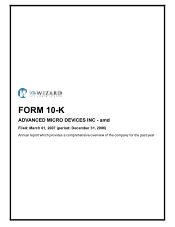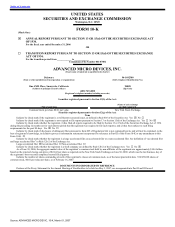AMD 2006 Annual Report Download - page 8
Download and view the complete annual report
Please find page 8 of the 2006 AMD annual report below. You can navigate through the pages in the report by either clicking on the pages listed below, or by using the keyword search tool below to find specific information within the annual report.
Table of Contents
invention of the transistor in 1948, improvements in IC process and design technologies have led to the development of smaller, more complex and more reliable
ICs at a lower cost per function. In order to satisfy the demand for faster, smaller and lower-cost ICs, semiconductor manufacturers have continually developed
improvements in manufacturing and process technology. ICs are increasingly being manufactured using smaller geometries on larger silicon wafers. Use of
smaller process geometries can result in products that are higher performing, use less power and cost less to manufacture on a per unit basis. Use of larger wafers
can contribute further to a decrease in manufacturing costs per unit and to an increase in capacity by yielding more chips per wafer.
The availability of low-cost semiconductors, together with increased customer demand for sophisticated electronic systems, has led to the proliferation of
semiconductors. Today, virtually all electronic products use semiconductors, including PCs and related peripherals, wired and wireless voice and data
communications and networking products including mobile telephones, facsimile and photocopy machines, home entertainment equipment, industrial control
equipment and automobiles.
During most of 2006, within the global semiconductor industry, we offered primarily:
• x86 microprocessors for the commercial and consumer markets, which are used for control and computing tasks; and
• embedded microprocessors for commercial, commercial client and consumer markets.
As a result of our acquisition of ATI in October 2006, we began to supply 3D graphics, video and multimedia products and chipsets for desktop and
notebook PCs, professional workstations, and servers as well as products for consumer electronic devices such as mobile phones, digital TVs and game consoles.
Therefore, since this acquisition, we have actively participated in the semiconductor graphics and chipset markets as well as in the semiconductor market for
consumer electronics devices.
Computation Products
The x86 Microprocessor Market
A microprocessor is an IC that serves as the central processing unit, or CPU, of a computer. It generally consists of millions of transistors that process data
and control other devices in the system, acting as the brain of the computer. The performance of a microprocessor is a critical factor impacting the performance
of a computer and numerous other electronic systems. The principal indicators of CPU performance are work-per-cycle, or how many instructions are executed
per cycle, clock speed, representing the rate at which a CPU’s internal logic operates, measured in units of hertz, or cycles per second, and power consumption.
Other factors impacting microprocessor performance include the number of CPUs, or cores, on a microprocessor, the bit rating of the microprocessor, memory
size and data access speed.
Developments in circuit design and manufacturing process technologies have resulted in significant advances in microprocessor performance. For
approximately the last ten years, microprocessors have had 32-bit computing capabilities. The bit rating of a microprocessor generally denotes the largest size of
numerical data that a microprocessor can handle. While 32-bit processors have historically been sufficient, we believe that they will face increasing challenges as
new data and memory-intensive consumer and enterprise software applications gain popularity. Microprocessors with 64-bit processing capabilities enable
systems to have greater performance by allowing software applications and operating systems to access more memory.
Moreover, as businesses and consumers require greater performance from their computer systems due to the exponential growth of digital data and
increasingly sophisticated software applications, semiconductor manufacturers have transitioned from manufacturing single-core microprocessors to also
manufacturing multi-core processors, where multiple processor cores are placed on a single die or in a single processor. Multi-core
3
Source: ADVANCED MICRO DEVIC, 10-K, March 01, 2007





















